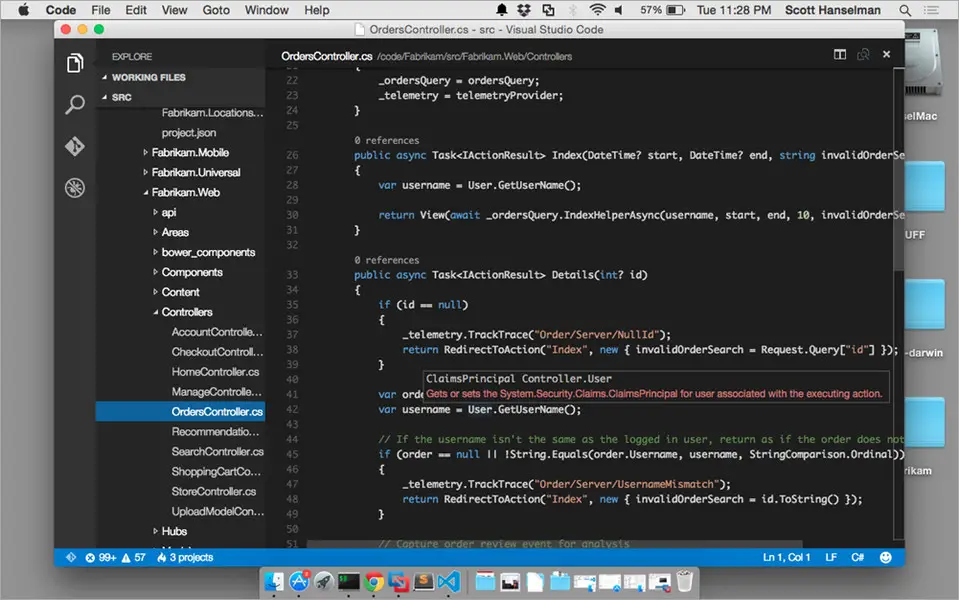- Visual Studio Code Duplicate Line Machine
- Visual Studio For Mac Tutorial
- Visual Studio Code Mac M1
- Visual Studio Code Duplicate Line Shortcut Mac
- Visual Studio Code Mac Install
Visual Studio Only - In a Visual C build, this can be used to stop the required system libs being automatically added to the link stage.jucecore: JUCEINCLUDEZLIBCODE: This can be used to disable JUCE's embedded 3rd-party zlib code. How to create a local copy of a remote branch in Visual Studio – 116 Suppose you’ve cloned a project from a GitHub repo that contains multiple branches. By default, Git pulls down the main tracking branch (e.g. Master in most cases). Duplicate selection or line. Duplicte functionality like you are used to. Adds duplicate text functionality to vscode similar to that in Sublime Text or Resharper. When nothing is selected, the whole line is duplicated and caret is placed on the lower line; When text is selected, the selection is duplicated and the new copy is selected.
 -->
-->This tutorial shows how to publish a console app so that other users can run it. Publishing creates the set of files that are needed to run an application. To deploy the files, copy them to the target machine.

The .NET CLI is used to publish the app, so you can follow this tutorial with a code editor other than Visual Studio Code if you prefer.
In the latest release of Visual Studio Code (May 2016) it is now possible to list the installed extension in the command line. Code -list-extensions On Mac, execute something like: '/Applications/Visual Studio Code.app//Contents/Resources/app/bin/code' -list-extensions To install, use:-install-extension //see 'code -help'. This topic applies to Visual Studio on Windows. For Visual Studio for Mac. Duplicate line: Ctrl+E,V. Toggle between the code editor window and the Peek.
Prerequisites
- This tutorial works with the console app that you create in Create a .NET console application using Visual Studio Code.
Publish the app
Start Visual Studio Code.
Open the HelloWorld project folder that you created in Create a .NET console application using Visual Studio Code.
Choose View > Terminal from the main menu.
The terminal opens in the HelloWorld folder.
Run the following command: Game 7 sins untuk android.
The default build configuration is Debug, so this command specifies the Release build configuration. The output from the Release build configuration has minimal symbolic debug information and is fully optimized.
The command output is similar to the following example:
Inspect the files
Visual Studio Code Duplicate Line Machine
By default, the publishing process creates a framework-dependent deployment, which is a type of deployment where the published application runs on a machine that has the .NET runtime installed. To run the published app you can use the executable file or run the dotnet HelloWorld.dll command from a command prompt.
Visual Studio For Mac Tutorial
In the following steps, you'll look at the files created by the publish process.

Visual Studio Code Mac M1
Select the Explorer in the left navigation bar.
Expand bin/Release/net5.0/publish.
As the image shows, the published output includes the following files:
HelloWorld.deps.json
This is the application's runtime dependencies file. It defines the .NET components and the libraries (including the dynamic link library that contains your application) needed to run the app. For more information, see Runtime configuration files.
HelloWorld.dll
This is the framework-dependent deployment version of the application. To execute this dynamic link library, enter
dotnet HelloWorld.dllat a command prompt. This method of running the app works on any platform that has the .NET runtime installed.HelloWorld.exe (HelloWorld on Linux, not created on macOS.)
This is the framework-dependent executable version of the application. The file is operating-system-specific.
HelloWorld.pdb (optional for deployment)
This is the debug symbols file. You aren't required to deploy this file along with your application, although you should save it in the event that you need to debug the published version of your application.
HelloWorld.runtimeconfig.json
This is the application's run-time configuration file. It identifies the version of .NET that your application was built to run on. You can also add configuration options to it. For more information, see .NET run-time configuration settings.

Run the published app
In Explorer, right-click the publish folder (Ctrl-click on macOS), and select Open in Terminal.
On Windows or Linux, run the app by using the executable.
On Windows, enter
.HelloWorld.exeand press Enter.On Linux, enter
./HelloWorldand press Enter.Enter a name in response to the prompt, and press any key to exit.
On any platform, run the app by using the
dotnetcommand:Enter
dotnet HelloWorld.dlland press Enter.Enter a name in response to the prompt, and press any key to exit.
Additional resources
Visual Studio Code Duplicate Line Shortcut Mac
Next steps
Visual Studio Code Mac Install
In this tutorial, you published a console app. In the next tutorial, you create a class library.
